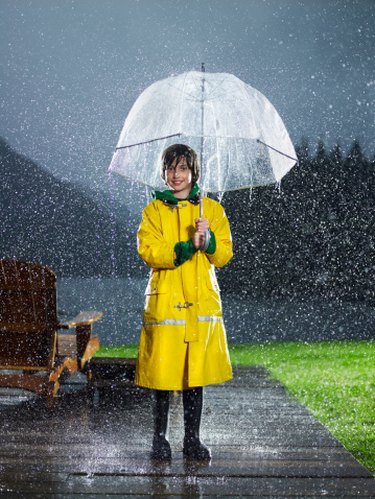
Swimming pool owners can add disinfecting and stabilizing chemicals as they please when it rains. However, continuous rain will adversely affect the water's chemical balances. This is because rain picks up atmospheric contaminants, such as organic materials and even algae spores, when it falls. Rain also can turn slightly acidic, throwing off a pool's pH level. It's usually best to wait until after a rain to add chemicals to a swimming pool. There are some basic strategies to follow before and after a rain to maintain a pool's chemical balance.
During Rainfall
Video of the Day
Knowing when a prolonged period of rain is forecast can allow you to prepare for certain chemical changes related to precipitation. Rain often is slightly acidic and especially so near large urban centers where pollutants are expelled in higher amounts from factories and automobiles. Rain also captures pollen and other organic materials that will end up in a pool. Add a bit more chlorine and pH balance chemicals than you might need when performing regular pool maintenance to account for these potential changes and maintain the pool's chemical balance.
Video of the Day
After Rainfall
In almost every case, you will have to add chemicals to a pool after it rains. Check the water's pH level first. However, if the pH level is too low (below 7.0), hold off on increasing the pH until after adding chlorine. Most chlorine formulations will increase a swimming pool's pH level slightly on its own. Typically, chlorine reading below 1.5 parts per million (PPM) will require adding enough chemical to raise the level to 2.0 PPM.
Adding Chemicals
The typical formula to follow when adding chlorine to a swimming pool is 1 pound of calcium hypochlorite commercial pool chlorine per 10,000 gallons of water. This should keep the chlorine level at the necessary 2.0 PPM. Check the chlorine level shortly after rain ends if the chemical was added just before or during rain. Once the chlorine has stabilized, work to bring the pool's pH levels to a reading of 7.2 to 7.4. Note that chlorine dissipates quickly when the pH level reads below 7.0 and works poorly at readings exceeding 8.0.
Frequency
During a prolonged rainfall, its best to check a pool's chemical balance every few hours. Doing so will prepare you to take action after rain stops. A prolonged rain definitely means that more chlorine and pH balancing chemicals will have to be added because they will be eaten up rapidly by elements within the rain. Continuously running the pool filter during rainfall also is recommended.